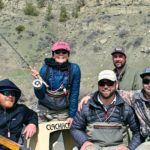By Patrick Straub EBS Fishing Columnist
In my 20s, I spent a lot of time fishing alone. From long day hikes to the meadows of Slough Creek to late nights fishing mouse patterns on the East Gallatin after the band at the Filling Station ceased playing, very few anglers could match my frantic fishing pace. Anytime I wasn’t working to make money to spend on fishing, I was wetting a line in our local waters.
As I reached my 30s, fishing became more social. Logging 130-plus days a year as fishing guide forced that hand a little, but I enjoyed a boat full of friends and beer more than the solitude of heading off on foot. Now that I’m in my 40s, having my wife and two kids with me in the boat is as good as it gets. When I do choose to fish with others, I choose wisely.
We can all use more friends, but choosing the best angling partner can involve a little trial-and-error. Here’s some insight for both you and your angling friend.
Similar angling interests. You obviously share a love of fly fishing. Be sure to choose an angling companion who shares a complimentary passion—chucking streamers, technical dry-fly fishing, hiking miles into remote waters to catch a native Grayling, into the carp game, and so forth. If you’re polar opposites, it will be tough to maintain the angling friendship. While fishing together you certainly fish differently, as it’s OK for one of you to deep nymph with a worm or an egg and the other to prospect with dry flies.

Don’t choose a cheapskate. A day of fishing usually entails burning some gas to get to a river. There might also be a sack lunch during the day or après fishing cocktails or dinner. Choose a companion who offers to drive every now and then. One who doesn’t flinch at buying a round when you catch a 2-footer. And, always look in the mirror—make sure you’re the guy driving some and buying some. This also applies if you have a friend with a boat. If you can row, row your fair share. If you cannot row and you’re fishing in your friend’s boat, you better learn to row if you want to be invited back.
Secrets are for loners. A surefire way to always fish alone is to catch fish but never be willing to share the love. I’m a firm believer in fishing karma and sharing information is a foundation of good fishing karma. If your angling companion is one worth keeping and you’re always catching and they are not, share the good news. Tell them what fly they’re biting on…but also let them self discover; you don’t always have to tell them what size tippet you are using and exactly where to place the fly.
A dog also counts as a fishing companion. Most of our fly fishing, at its core, is an experience between an angler, a river and the hope a fish will rise. Bringing your dog on a fishing trip with other anglers is not always the best idea, but an angling session with just you and your dog is often ideal. A dog will never comment on your back cast, is always happy to go fishing, and will most likely fall asleep on the way home.
With a family and two businesses, finding personal time to fish—where it’s just me, the river and the flies I choose to tie on—is hard-fought time to come by. I’m lucky because I can fish anytime I want. I’m unlucky because I’m too choosy about fishing companions but I’ve also had well over half my life to find out what I like and whom I want to enjoy it with.
Pat Straub is the co-founder of the Montana Fishing Guide School and the author of six books, including “Everything You Always Wanted to Know About Fly Fishing.” He and his wife own Gallatin River Guides in Big Sky and he co-owns Montana Fishing Outfitters.













